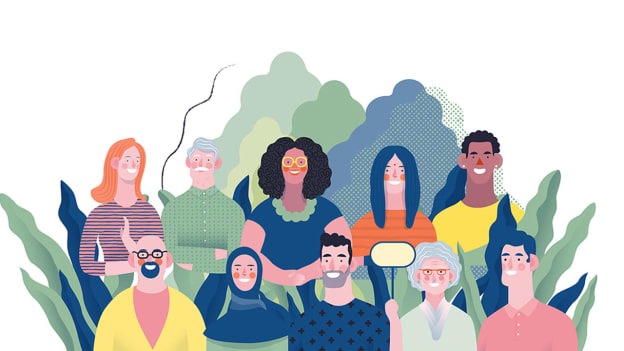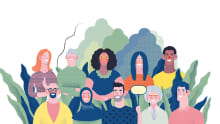Diversity and Inclusion - The new 'social un-conditioning'

With various sections of media pointing out the lack of diversity in entertainment, science and literature awards, inclusivity and diversity get the spotlight, again. I remember someone mentioning a series where a surgeon with autism proves to be an asset to the whole team when the team regards him as a surgeon and not as a special one. He also has a rub off in making other team members in sharpening their ‘out of box’ thinking in solving medical situations. That brings to the crux of the matter. I feel inclusiveness is natural once we treat others as a human.
The whole idea of diversity stems from a realization that a co-worker is different from one, the basis of say lifestyle choices or color or orientation. This realization brings with itself the stereotypical persuasions and subconscious actions. The concept of diversity is very subjective, with certain organizations treating educational background, experiences and even generation as a bias for diversity.
Irrespective of the bias, the fact is that the question of ‘being different’ rises. ‘When you accept another as a human there are no differences.’ I feel that once we treat our co-workers, partners, and everyone as a human, we rise above the ‘diversity’ aspect. Yes, we need to be sensitive and caring about other’s needs and situations, in a mature human way.
If the realization happens that ‘my co-worker’s skills are complementary to mine’ or ‘my co-worker is a great human being and helps me at work’ the whole approach changes. The point being, when we treat others as ‘humans’ and respect them, the preconceived stereotypes and notions of ‘diversity’ will not arise at all. Recall how in our childhood, a friend is a friend, there was no concept of segregation of friend based on any biases. Gradually, we pick up the concepts of differentiation. We as adults tend to imbibe these classifications over the years and carry our burden of stereotypical learning to the workplace.
Subconsciously, these enter our approach in professional and personal interactions. There is a huge opportunity to unlearn these at the workplace. This calls not only for a few seminars, workshops or posters. This approach of inclusivity comes from each person. Just by seeing the co-worker or team member as a human and respecting them for their choices, opinions, and views will organically and automatically make any organization or company inclusive. What is important is talent, team spirit and achieving together, with mutual respect and consideration.
People are shaped by experiences and exposures, and when there is a team with different backgrounds, it may take time for everyone to be on the same page. Keeping the communication open and honest between team members helps to sort out lots of issues. But you can’t force people to work together by an iron fist. In most cases, respect develops gradually as team members start working together. Creating an environment where each one can voice opinions freely is very important for such teams.
A way to ‘unlearn’ is by having interactions that are not bound by preconceived notions or biases. Being inclusive is also about giving opportunities and responsibilities to all, to the best of one’s experience or skill. This can foster innovations. With a diverse skill-set and thinking, it is easier to innovate. Initially, there may be few hitches, but with time and with measured support from HR or any other leader, all gets ironed out. Teams with people of different talents, experiences, and perspectives can help in ‘exploring’ a situation from a new or different approach.
Regular sensitization workshops including one to one discussion do help in making the work environment friendlier and supportive. It is known that an employee is motivated and engaged to work when the environment is inclusive, supportive and open.
Most of the ‘unlearning of biases’ depend on an individual that how much they want to shed the baggage of socio-cultural stereotyping and notions. Step one for us is to identify and realize that we have been conditioned. Once that is done, unlearning will be easier. The only difference is while we have learned un-knowingly and un-intentionally, but we must ‘un-learn’ knowingly and deliberately.
Company policies do help; it’s the onus of managers and top management to lead by example in inclusiveness. The vision of an organization can be a compass that determines the course in this direction. An organization’s policies and practices should spell it out clearly. More the work culture should be inclusive in all sense.
Equal opportunity is very important. Acknowledging and promoting ‘diverse’ talent is critical. Not only from retention of talent but more from attracting new talent. When an organization is seen promoting and valuing ‘diverse’ talent, it gains valuable goodwill. Leaders need to be inclusive in the sense that let employees share ideas, take feedback and act on them, discuss openly and letting team ‘own’ the projects or assignments. Even more, designing and having a clear career path for the employees is helpful. It is well known that employees who feel ‘less valued’ tend to leave faster. And, in the case of women employee’s caregiving responsibilities and ‘stagnant’ career growth also makes them leave the workforce. Flexible timings, work from home, reskilling options, mentoring or handholding at crucial stages are a great way to retain and promote talent.
Verna Myers as an inclusion strategist said that ‘Diversity is being invited to the party; Inclusion is being asked to dance’. An employee will give best only when they feel that they belong to the team or company. When they are valued, and their contribution is acknowledged as humans. That is new UnConditioning which is the need of the hour.
















